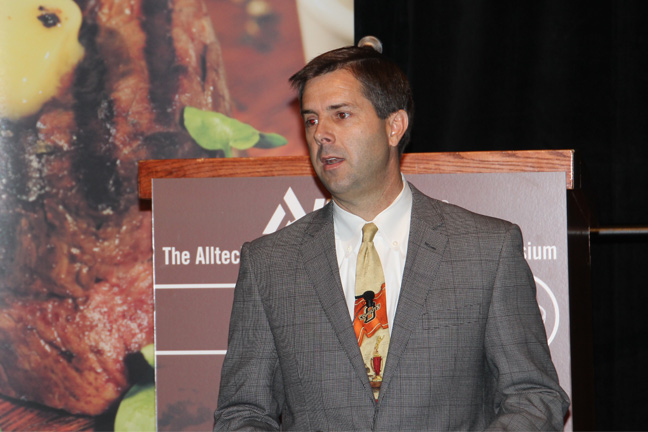
Agricultural News
Lalman Says Moderation is the Key to Maximim Profits in Oklahoma Cow-Calf Operations
Wed, 23 May 2012 15:59:30 CDT

Dr. Dave Lalman from Oklahoma State University spoke at the Alltech Ag Futures Symposium in Lexington, Kentucky, on the future of the cattle business. Lalman spoke with Ron Hays about trends in the cattle business and how cow-calf producers can improve their efficiency.
Lalman said it was easy to see how frame size swung toward the ever larger size from the 1940s to the 1980s. He said frame size is easy to see and select for and perhaps the pendulum swung a little too far to the large end of the spectrum for maximum efficiency.
Even though we now have more genetic tools at our disposal than we did in years past, finding the right balance is not always easy.
"Now we have the tools to increase milk production, to increase muscling, to monitor mature size and so on, and so we sort of get caught up in the idea that because we have those tools that more is better. And all I was trying to encourage folks to consider here today is that if it's a commercial cow-calf operation with a moderate level of inputs or even low inputs with a forage base, hopefully, that moderate genetic selection at least in terms of mature size, milk and muscle is probably more appropriate."
Just like with all things, moderation can be in the eye of the beholder, but Lalman said, there are quantifiable benchmarks that can be used.
"In the little bit of data we've collected on commercial cow-calf operations here in Oklahoma, it looks like for every additional 100 pounds of cow weight, we get about six pounds additional calf weaning weight and that's just not a very good trade off. It costs a lot more to keep that extra 100 pounds around a year than the additional six to eight dollars that that additional six pounds is worth."
He said that more and more producers are returning the crossbreeding to maximize their operation's efficiency.
"Crossbreeding is not just a free lunch like we've often talked about in the past, but it does represent a tremendous improvement in cow-calf efficiency because you get the F1 female, you get a 25 percent increase in weaning weight over her lifetime which comes from increased longevity of the cow and improved reproductive efficiency. We don't get those things very easily by staying within a breed."
Lalman said it all amounts to paying careful attention to the operation's bottom line.
"I think we are not paying as much attention to the bottom line if you're a commercial cow-calf enterprise. And it's difficult to determine exactly where you need to be from a genetic stand point if you're a commercial operation. But I suspect that our costs have continued to increase year after year. Maybe only slightly, but I think they have increased because we have continued to select for more and more productive animal-growth, mature size, milk, muscling. All those things cost money to keep around.
"What little data we have says that when you have low inputs and you're trying to keep your costs down, you cannot take advantage of all that genetic power. I think our costs have probably increased because we have cows that have higher maintenance requirements than we used to have and productivity has not increased accordingly."
He said that Oklahoma producers, especially, can maximize their returns if they will "look for animals to put back in your commercial operation seed stock that are moderate in mature size, maybe even more moderate in growth, certainly moderate in milk and, as difficult as this is for a producer to swallow, maybe even moderate in muscle. You want to match the cow to the environment and the bull to the market. So if you want heavy-muscled calves, go buy a heavy-muscled bull and don't, maybe, keep the heifers."
You can hear the Ron Hays' full interview with Dr. Dave Lalman by clicking on the LISTEN BAR below
WebReadyTM Powered by WireReady® NSI
Top Agricultural News
More Headlines...




















